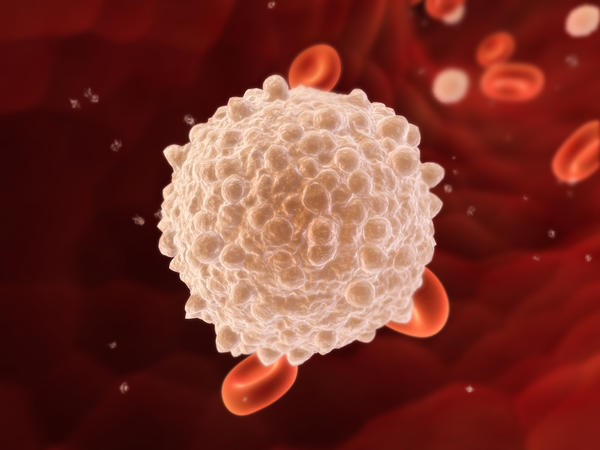In human body, white blood cells are like soldiers that constitute the immune system. They act like guards and protect our body from all micro organisms and other factors that could harm our body. Their count in our body, plays a vital role. Blood consists of several different components and for each, there is a range, count should be in between this range. But there are many disorders in which different components of blood become increased or decreased, which leads to different diseases.
White blood cells also known as leukocytes. This term came from Greek language and it is basically combination of two words ‘leuko’ means white and ‘cyte’ means cell. Normally there are around 7000 white blood cells per microliter of blood. White cells constitute 1% of the total blood volume in healthy adult individuals. Usually for each component given a range, i.e. upper limit and lower limit.A decrease below the lower limit is called leukopenia. In leukopenia there is a diminished white blood cell count. Having this medical condition, the immunity of patient is severely weakened and the individual has greater risk of infections. Leukopenia may be caused by diseases, medications, and genetic deficiencies.
Leukocytes are generally classified according to the presence of granules within them. The ones with granules are the granulocytes while the ones without are the agranulocytes. Granulocytes are also known as polymorphonuclear leukocytes. These possess granules which are actually membrane-bound enzymes acting on the invading organisms that have been engulfed by the cell. Neutrophils, basophile and eosinophils are main types of granulocytes. While agranulocytes, also termed as mononuclear leukocytes and do not have granules in their cytoplasm. These contain some azurophilic granules, which are actually lysosomes that help in killing the invading organism. The cells include lymphocytes, monocytes, and macrophages.

Leukocytopenia (Leukopenia, Leucopenia) Causes, Symptoms, Treatment
Here you can find all relevant information about Leukocytopenia including its causes, symptoms and available treatments.
Causes
Following are some possible causes of this medical condition.
- Main cause of the Leukocytopenia is supposed to be Neutrophilia. Due to an infection, the Polymorphonuclear Leukocyte may occur. Major Infections cause Neutrophilia, however it increases with the increase in the degree of infection.
- If Bone Marrow gets heavily damaged, it can also lead to Leukocytopenia.
- HIV and AIDS are the other prime reasons for this Leukocytopenia disease. Therapies can severely damage the WBC and cause the less count to induce Leukocytopenia.
- Some other medical conditions like Myelofibrosis, lymphoma, Rheumatoid arthritis, Systemic Lupus Erythematosus, Congenital disorders and Folate deficiency can also be the reason behind the Leukocytopenia.
It can be concluded that if a person has lack of white blood cells, due to any reason or medical condition, this decreased count can cause Leukocytopenia.
Symptoms
Since white blood cells are responsible for immune system of the body and in Leukocytopenia, the patient has less count of WBC, that means, the body from the foreign materials like bacteria and virus is less protected. Human body might not be able to resist the other diseases. Symptoms include:
- Anemia, the most common and obvious symptom of this medical condition. As the White Blood Cells reduce, it may lead to Thrombocytopenia due to the damage of bone marrow.
- Due to an easy prey for the Bacteria and Virus, patient’s lungs become an easy victim and the inflammation of lungs.
- Pneumonia is another common symptom.
- Stomatitis, which involve inflammation in the gums, cheeks, lips, tongue and other organs, is another common symptom.
- Liver may largely affected by the bacteria. Liver infection becomes a headache for the patient.
- Continuous bleeding from Uterus is commonly seen in women that further causes Metrorrhagia and it also triggers heavy and long menstruation, which is also known as Menorrhagia.
Treatment
Treatment of leukopenia depends on the cause of the condition. That’s why clear diagnosis is vital for this condition.
- In order to diagnose this condition, a complete blood count is examined. Counts less than 1000 cells/µL are dangerous and may raise the risk of infections.
- If there is a bone marrow suppression due to medications like anti-cancer chemotherapy, stopping the drug may often cause recovery in the white blood cell counts.
- Leukopenia that is caused by genetic conditions may need granulocyte colony-stimulating factor and other bone marrow–derived growth factors to stimulate production of the WBCs.
- Practically the WBC count differs in accordance with the age and body, so a certain count is not applicable for all. The resistive power of every individual is different and there is no specific cause to it.
- The doctor might put the patient on the Antibiotics in order to prevent the bacteria and sepsis related danger in the body. Adequate nutrition is also provided to the patient to overcome the deficiency.
- In severe cases, Cytokine can be placed in the patient so that bone marrow can reproduce the White Blood Cells. Drugs are also applied to overcome Leukocytopenia
 Health & Care Information
Health & Care Information 

